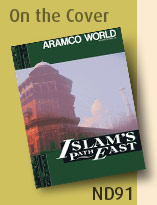View this map larger

A Note From the Editors
 n the thousand years between the fall of Rome and the discovery of the New World, no single event in history was more significant than the rise of Islam. United by the monotheistic religion revealed to the Prophet Muhammad in the early seventh century, the Arabs overthrew the Persian Empire in Iraq and Iran and expelled the Byzantines from Jordan, Palestine, Syria and Egypt.
n the thousand years between the fall of Rome and the discovery of the New World, no single event in history was more significant than the rise of Islam. United by the monotheistic religion revealed to the Prophet Muhammad in the early seventh century, the Arabs overthrew the Persian Empire in Iraq and Iran and expelled the Byzantines from Jordan, Palestine, Syria and Egypt.
By the year 750 the Islamic realm reached from the Atlantic to the borders of India and China, and the brilliantly intellectual and artistic courts of its Muslim rulers outshone all their rivals’.
Further conquests by non-Arab Muslims carried Islam across the rest of India, where the Moghuls created one of the most sophisticated civilizations in history, epitomized by the graceful Taj Mahal. Meanwhile Muslim traders and missionaries spread the faith even farther east to Indonesia, the Malay Peninsula and southeast China.
In marathon journeys during 1990 and 1991, Aramco World contributing editor John Lawton traced the world-altering eastward path taken 14 centuries ago by the Muslim religion, now the faith of nearly one billion people around the world.
In the company of Saudi Aramco photographer Abdullah Dobais, Lawton’s travels began in the land where the Qur’an was revealed to the Prophet Muhammad, in what is now Saudi Arabia, and continued into the Sultanate of Oman. With free-lance photographer Bill Lyons of Amman, Lawton also traveled the route of the new revelation north and east into Palestine and Jordan. Then, accompanied by Nik Wheeler, a freelance photographer based in Los Angeles, Lawton set out along the route east traveled in earlier centuries by the Muslim armies and Arab traders whose most effective unifying force, and most enduring cargo, was Islam.

LAWTON |

WHEELER |
Traveling by airplane, train and car — and intermittently aboard the Sultan of Oman’s yacht Fulk al-Salamah, lent to UNESCO to trace ancient trade routes — Lawton and Wheeler crossed Pakistan and Malaysia, Indonesia and China, ending their trip in Quanzhou, one of the southern Chinese ports through which Islam entered some 1300 years ago.
Lawton and Wheeler had traveled to China before, writing and reporting for Aramco World on Turkic Muslims in 1984, and Lawton had crossed into China from the Soviet Union in 1987 to report on the trans-Asian Silk Roads, also a pathway along which the teachings of Muhammad had made their way east. Drawing on these journeys, as well as on one undertaken with photographer Francesco Venturi in researching their recent hook on Samarkand and Bukhara, Lawton has brought together the story of one of world history’s seminal events: the spread of the Muslim religion from its birthplace in western Arabia to its farthest eastward expansion.
Other contributors whose knowledge and talents have been vital in creating this issue of Aramco World are former Aramco chief photographer S. M. Amin, free-lance artist and illustrator Michael Grimsdale, designer Peter Keenan, and consulting editor Ismail I. Nawwab.

NAWWAB |

AMIN |

DOBAIS |

LYONS |

VENTURI |

GRIMSDALE |